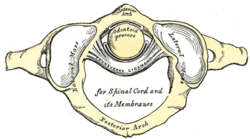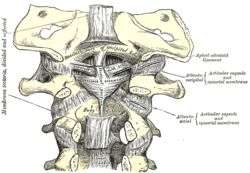|
Transverse ligament of atlas
In anatomy, the transverse ligament of the atlas is a broad, tough ligament which arches across the ring of the atlas (first cervical vertebra) posterior to the dens[1] to keep the dens (odontoid process) in contact with the atlas.[citation needed] It forms the transverse component of the cruciform ligament of atlas. StructureThe length of the ligament is variable; its mean length is 2 cm.[1] The ligament broadens[1] and thickens[2] medially. The anterior medial aspect of the ligament is lined by a thin layer of articular cartilage.[1] The neck of the odontoid process is constricted where it is embraced posteriorly by the transverse ligament[2] so it retains the dens in position even after all other ligaments have been sectioned.[1] AttachmentsThe ligament attaches on either side onto a small yet prominent tubercle upon the medial aspect of either lateral mass of atlas.[1] Cruciate ligamentA strong median band (crus superius[2]) extends superiorly from the superior margin of the ligament to attach onto the basilar part of occipital bone (between the attachments of the apical ligament of dens, and tectorial membrane). A weaker and somewhat inconsistent median band (crus inferius[2]) extends inferiorly from the ligament to attach onto the posterior aspect of the[1] body of[2] axis. The ligament and the two median bands together constitute the cruciate ligament of atlas.[1] RelationsThe transverse ligament divides the vertebral foramen of the axis into an anterior portion (constituting one third of its lumen) which contains the dens, and a posterior portion (constituting two thirds of the foramen's lumen) which contains the spinal cord and its coverings[1] as well as the two accessory nerves (CN XI).[2] Clinical significanceExcessive laxity of the posterior transverse ligament can lead to atlantoaxial instability, a common complication in patients with Down Syndrome and Ehlers–Danlos syndrome. Laxity has also been hypothesized as the cause of degenerative hypertrophy and mechanical atlantoaxial stress.[3] Degenerative processes can give rise to transverse ligament cysts, resulting in progressive cervical myelopathy. The treatment of choice for transverse ligament cysts with progressive neurological decline is surgical resection and cervical fusion.[4] Conservative treatment with external neck immobilization is less commonly reported , but may be very useful in select cases where immediate surgical intervention is not indicated.[5][6] See alsoReferences
|
||||||||||||||||||||

